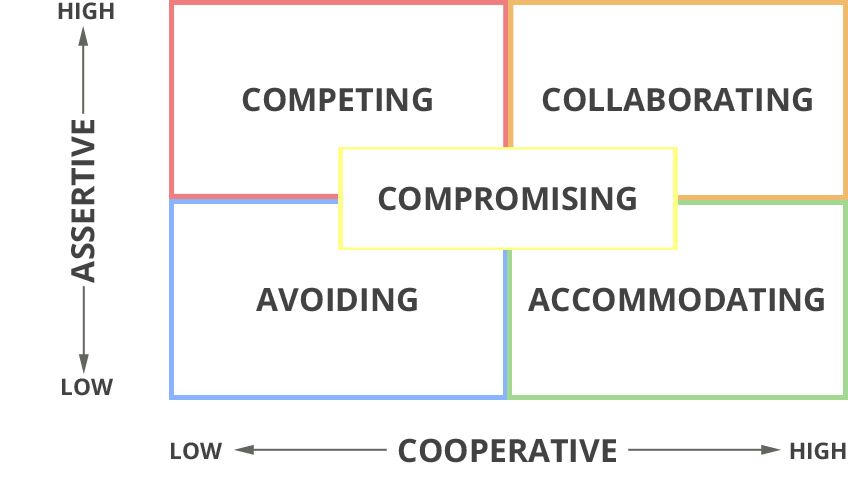Bring together a group of people to work on a project or in the workplace and there is bound to be conflict at some point. Everyone has a different need, goal, attitude, or outlook which doesn’t always agree with someone else’s. A key skill of any project or team manager is conflict resolution in the workplace.
It’s important that any conflict that arises is dealt with quickly and professionally to avoid the issues affecting morale and productivity and ensure there isn’t any delay to a project’s completion. Everybody deals with conflict in a different way and how the project manager deals with it can impact the whole team. In the early 1970s, Kenneth Thomas and Ralph Kilmann identified 5 conflict resolution strategies that help people handle a conflict and reach an agreed resolution.
Conflict resolution strategies
Thomas and Kilmann based their strategies on the choices people make about how assertive or cooperative they will be in a conflict. Everyone has a different, preferred approach to managing conflict in the workplace; understanding these strategies can help move a project or team forward when a conflict occurs.
Strategy 1 – Avoiding
This is when people seek to withdraw from or ignore any conflict, usually because feeling uncomfortable about the confrontation outweighs any possible reward from resolving it. The problem is that this strategy doesn’t really resolve the issue because there is a lack of contribution to the conversation.
Strategy 2 – Competing
People who are overly assertive rather than cooperative enter into conflict resolution with the intention of winning. There is an assumption that one person wins and the other loses, pushing out any chance of seeing a different perspective. As a result, this is not usually a good strategy for resolving conflicts within a group.
Strategy 3 – Accommodating
Giving in to the wishes or demands of another is being cooperative, but not assertive. Yes, it appears that the person is being gracious should their argument be incorrect, but when a person gives in just to keep the peace, it isn’t necessarily helpful. Similar to “avoiding”, it doesn’t always lead to a satisfactory resolution to an issue, and leaves the door open for more assertive members of the group to take control.
Strategy 4 – Collaborating
For most project or team managers, this is probably the strategy they’ll use. A collaborative person is cooperative and assertive at the same time, allowing each member of the group to contribute and then resolving the issues by establishing a shared solution that all can support.
Strategy 5 – Compromising
The last strategy is similar to “collaborating” but the person is only halfway towards being assertive and cooperative. The concept is that each member of the group gives up something so that no member gets everything. This is perceived as the best outcome, working to a compromise that is fair although, often, no one is completely happy with the final resolution.
At PMQ, our project management courses from ILX Group incorporate methods and strategies for managing and resolving conflicts within projects and groups. PMQ’s professional, industry-recognized e-learning and classroom-based courses give course participants all they need to successfully lead and manage small- and large-scale projects.
